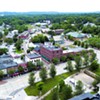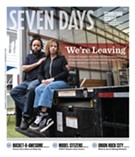Published August 28, 2006 at 4:45 p.m.
Jay Purvis and his wife Jackie Ward have a spectacular view from their beachfront South Hero home; on a clear day, they can see across Lake Champlain to the ridgelines of the Adirondacks. But before they could watch the summer sunset from their front patio, they had to build a few hundred birdhouses.
Purvis explains that, until recently, he and his wife were tormented by hordes of hungry mosquitoes that rose from their backyard marsh each spring. "We could not sit outside without being eaten alive," recalls the 59-year-old IBM retiree and South Hero Selectboard member.
That changed after Purvis read on the Internet that he could control the bugs by attracting tree swallows. He started building a few birdhouses 10 years ago, which he hung on the trees behind his house. But it wasn't until four years ago, when he enlisted help from his neighbor and "manufacturing supervisor" Hank Bischoff, that he began to see a decline in the bug population. Together, Purvis and Bischoff have built and hung more than 300 birdhouses in the grove of ash and cedar trees behind their Lakeview Road homes. When the tree swallows show up in the spring and fall, roughly 90 percent of the houses are occupied.
The birdhouses haven't just solved Purvis' pest problem; they've become something of a public art project. That's because Bischoff paints them in bright hues of lemon yellow, tangerine orange, fire engine red, royal blue and lavender - the avian equivalent of Stu McGowan's multi-colored houses in Burlington.
Purvis' wife picked the palette. "She decided on jellybean colors," he says. "That's why we call them the 'jellybean suites.'"
Now this peculiar roadside eye candy competes with the lake vista for a passerby's attention. Says Purvis: "We've had a lot of people stop and take pictures."
It's easy to see why. Birdhouses adorn each of the trees that rise above the cattails in Purvis' roadside marsh. They hang at varying heights just above eye level, scattered throughout the stand of trees; nearly every trunk sports a specimen. Some have been painted just one color - baby blue, for example - others have red roofs and purple walls. Some feature three different shades; in the woods behind Purvis' two-story tan home is a birdhouse with a red roof and sides, and purple stripes framing an orange front.
Driving east on quiet, rural West Shore Road, the colorful crescent is impossible to ignore.
The concierges of this odd avian housing development are accommodating, to say the least - even with a reporter. Bischoff, 77, is a retired typesetter. For years he had his own shop in Washington, D.C. - Georgetown University and the World Bank were two of his clients. He and his wife Izzie moved to South Hero a decade ago.
Though he's stopped "working," Bischoff stays active. A weekday morning visit to his modest, single-story home finds him in a black Puma workout suit, his gray hair still damp from leading an exercise class. After a brief interview, he heads back out for a round of golf.
Bischoff seems pleased to talk about the birdhouses, and proudly shows a reporter the basement workshop where he makes them. When he turns on the lights in the room, it's immediately clear that making birdhouses isn't his only hobby. A back wall of the unfinished basement is lined with several handmade kites - including one that looks like a shark, another in the shape of a butterfly, one with arms and legs that resembles a young boy. Suspended from the ceiling is a radio-controlled glider with a 3-foot wingspan; another plane hangs on a nearby wall.
But most impressive is Bischoff's model railroad - he's built a large elevated triangle composed of two parallel tracks that run around the room. "I built it so I could walk under it," he explains.
Two miniature trains heading in opposite directions occupy the tracks, and Bischoff powers them up when asked. The trains rumble around the room while he talks about his more public creations. The birdhouses are relatively easy to make, he says. Purvis supplies him with the wood and the paint, most of which is scrap donated from local contractors and hardware stores. "Jay is a great scrounger," he quips.
Bischoff crafts the birdhouses in batches of 20 to 30 at a time. Over the years he's experimented with different methods, but he's finally perfected the formula. He sets the electric saw in his garage to cut each piece of wood to precisely the right length, then takes the pieces downstairs, where he drills the holes. Each birdhouse requires 17 screws and one nail.
Bischoff screws together the four walls and the floor, then applies the paint, which he keeps in cans neatly stacked on the metal shelves next to his workbench. At first he painted the houses one solid color, then he experimented with multiple colors on each house, but that didn't last. "I got to figure, that's too much work," he explains. Now he uses just two colors per house - red for the roof and another shade for the walls.
His other laborsaving device is each house's single nail. It fits into a hole near the bottom front corner of the left wall. Bischoff picks up a newly painted purple birdhouse with a red roof to demonstrate how the nail can be removed by hand. He takes it out of the hole and lifts the front wall. "They hinge up easily," he explains, "so you can clean 'em out." The birds won't come back unless their accommodations are empty of old nests and other debris.
Bischoff says Purvis hauls a ladder into the woods to empty the birdhouses each spring. Purvis also hangs the houses. "I don't help him do that anymore," says Bischoff. "I don't get around too well in the woods."
Bischoff is aware that people appreciate his handiwork. He gets numerous requests for the birdhouses, which he sells for $10 a pop, painted or unpainted. The business is all word of mouth. "I don't peddle 'em," Bishkoff says.
He also notices people slowing down to take a look. Of course, now they might also be gawking at the 5-foot-tall, four-legged Fiberglas dinosaur that Purvis planted a couple weeks ago on the beach access across the street from his house. But no doubt the birdhouses will continue to get their share of stares.
Purvis says he recently received a card from a North Hero woman thanking him for the colorful display. It featured an elaborate 3-D drawing of his marsh surrounded by birdhouses and contained a handwritten message: 'Thank you for your random act of beauty."
Purvis proclaims proudly, "We're having it framed."
More By This Author
Speaking of...
-

Q&A: Catching Up With the Champlain Valley Quilt Guild
Apr 10, 2024 -

Video: The Champlain Valley Quilt Guild Prepares for Its Biennial Quilt Show
Apr 4, 2024 -

Q&A: Meet a Family in Waterbury That Embraces Halloween Year-Round
Feb 14, 2024 -

Video: Goth Family in Waterbury: Sarah, Jay and Zarek Vogelsang-Card
Feb 8, 2024 -

Q&A: Art Entrepreneurs Tessa and Torrey Valyou Celebrate 15 Years of New Duds
Oct 11, 2023 - More »
Comments
Comments are closed.
From 2014-2020, Seven Days allowed readers to comment on all stories posted on our website. While we've appreciated the suggestions and insights, right now Seven Days is prioritizing our core mission — producing high-quality, responsible local journalism — over moderating online debates between readers.
To criticize, correct or praise our reporting, please send us a letter to the editor or send us a tip. We’ll check it out and report the results.
Online comments may return when we have better tech tools for managing them. Thanks for reading.














































